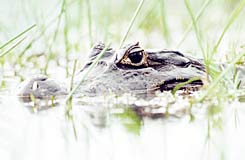
"Cayman" refinery in Brazil. "There are mosquitoes that live in the sewer system, they get used to everything," said a mosquito expert
From Meriva, Brazil. When night falls, the water here comes to life. The muskrats raise their heads, one after the other, lifting them above the surface of the water, and in a short time the Amazon river channel is infested with muskrats, whose length sometimes reaches more than 4.5 meters. The sounds of their banging, splashing and growling echoes through the night.
Until about 30 years ago, the caiman, a cousin of the American crocodile, was close to extinction due to the great demand for its skin and meat. As a result, the government banned the hunting of muskrats. However, the actions taken to protect the black and bespectacled muskrat were such a success that the muskrat population grew so much that they became a nuisance and even a threat in the eyes of some people.
The farmers, who live along the river, complain that the Masachians prey on the animals they raise, and demand that they be given back the right to hunt them. Texts that attacked small children provoked severe criticism in the local media, that the authorities have no idea of the harsh reality of life near the river.
However, the loudest protest against the hunting ban came from the fishermen in the Amazon. According to them, the fishers damage their fishing nets, the price of which ranges from 50 to 200 dollars, and they feed on the same type of fish that they themselves catch and sell. "Every time you go out to fish, they bother you," said Admar Nunes Nogueira, 41, who has been working as a fisherman since the age of 10. "But if you kill a fish and the environmental organizations catch you, you are the one who has to pay a fine."
Even in Manaus, a city of 1.5 million inhabitants on the banks of the Amazon, the presence of the Mexicans is very noticeable and far from being an urban legend. "There are reptiles that live in Manaus' sewage system," said Willitam Magnusson, a reptile expert from the city's Amazon Research Institute. "They get used to everything."
The population explosion of the mesothelioma has also become a political issue in the Amazon, after campaigning politicians promised to remove the law against mesothelioma hunting. "Their argument is that if you hunt in the US, why is it not allowed to hunt here as well"? explained Ronis de Silveria, a biology lecturer at the Federal University. No one knows the exact number of mesothelioma living in the waters of the Amazon today, but according to Magnusson, it is tens of millions. The fish are so numerous that some fishermen have begun to use their meat as bait to catch a certain type of catfish, which is imported to Colombia and is considered a delicacy there.
The government, for its part, defends the hunting ban and claims that canceling it will return the situation to normal. According to government officials, the propaganda to repeal the ban serves the interests of the farmers along the river who wish to increase their incomes, and is based on superstitions and ancient human fears of reptiles.
